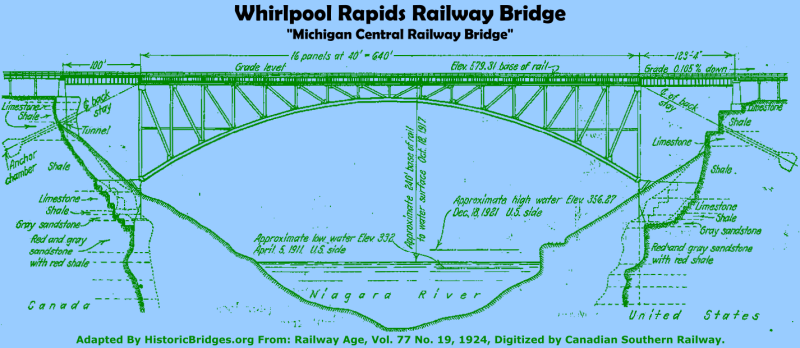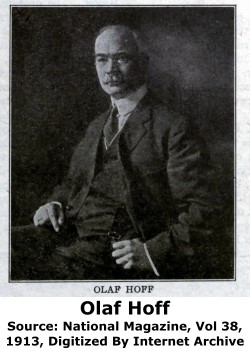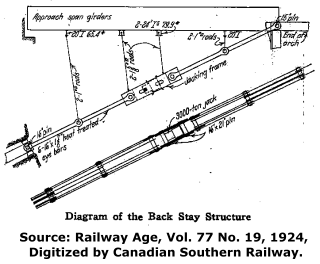We Recommend:
Bach Steel - Experts at historic truss bridge restoration.
Whirlpool Rapids Railroad Bridge
Michigan Central Railway Bridge

Primary Photographer(s): Nathan Holth
Bridge Documented: 2005 and March 20, 2012
Niagara Falls: Niagara Region, Ontario and Niagara County, New York: Canada and United States
Metal 16 Panel Three-Hinged Solid Ribbed Spandrel Braced Deck Arch, Fixed and Approach Spans: Metal Deck Girder, Fixed
1925 By Builder/Contractor: American Bridge Company of New York, New York and Engineer/Design: Olaf Hoff of New York, New York
Not Available or Not Applicable
640.0 Feet (195.1 Meters)
863.3 Feet (263.1 Meters)
Not Available
1 Main Span(s) and 2 Approach Span(s)
Not Applicable

View Information About HSR Ratings
Bridge Documentation
Additional engineer information: While Olaf Hoff is perhaps the most well-known engineer associated with the design of this bridge, William Perry Taylor and J. L. Delming were also engineers who played a design role for this bridge.
View historical articles discussing construction of this bridge and demolition of previous bridge.
View a historical article discussing the previous cantilever truss bridge at this location.
View a short historical discussion of Olaf Hoff.
This bridge is a monumental example of a steel deck arch bridge. It is located next to the older 1898 Whirlpool Rapids Highway Bridge, also a steel deck arch bridge. Constructed over 2 decades later, the Michigan Central Railway Bridge used a bridge design that was by then well-established thanks to earlier bridges like the 1898 bridge. Despite this, the bridge remains an exceedingly significant heritage structure due to its size, and also its lack of alteration. The bridge has no significant alterations from its original design and materials. Also, with the exception of the small collection of additional bridges on the Niagara River itself, large-scale deck arch bridges of this scale are very rare in this region, both in the United States and Canada, but particularly in Canada.
Its unique location next to the 1898 highway bridge make this setting a unique place to see two bridges of this design side-by-side. It allows for a visual interpretation of the evolution of steel arch bridge design and construction. Visitors can easily compare the details of the 1898 bridge to the 1925 bridge.
A number of engineers have been associated with the project. A period article about the bridge by Railway Age comments that the design of the bridge was developed under H. Ibsen, bridge engineer of Michigan Central Railway. Olaf Hoff of New York, New York was listed as the consulting engineer. Contemporary sources also list William Perry Taylor as a Chief Engineer. Olaf Hoff is by far the most significant name associated with the bridge. One of his major feats was the construction of the Detroit River Railway tunnel, which was constructed by sinking tunnel sections to the river bottom, a revolutionary method at the time.
Like its neighboring Whirlpool Rapids Bridge, the Michigan Central bridge was not erected using the traditional method of falsework used for arch construction. Instead, a temporary method of cantilever construction was used. However, an unusual detail employed with this particular bridge was the use of a back stay that attached to each end of the arch and was anchored the rock of the Niagara Gorge, deep within a tunnel that was constructed for the purpose. As such, the bridge took what was essentially an obstacle, the gorge, and turned it into a tool to help complete the bridge, using the solid rock of the gorge.
Current Status of Bridge as of 2014
This bridge was considered for demolition, but an email to the city of Niagara Falls, Ontario got a response indicating that "City Council has not been approached by CN/CP and are not aware of any plans for the demolition or modification of this structure." As such, it appears that the bridge is currently not at risk for demolition. Discussion of previous demolition plans is retained below for reference.
Discussion of ca. 2001 Demolition Plans
Despite the fact that there is no "common sense" reason to do so, and despite the extremely high level of heritage significance of this bridge (the bridge should be considered nationally significant in both Canada and the United States, this bridge is at risk for demolition! The demolition of this bridge would be both pointless and wasteful, and it is hoped that plans to demolish this bridge will be canceled. This bridge deserves to be left standing as a non-functional exhibit, which is how the bridge has existed since 2001.
In 2001, Niagara Falls, Ontario made a deal with Canadian Pacific that got the railway company to abandon this railway line, which ran right through the tourist district of the city and was considered a nuisance and safety issue. The city apparently also made a strange deal with the railway company. It appears that Canadian Pacific would continue to own the abandoned railway bridge and take care of any emergency maintenance issues, but would eventually demolish the bridge. The demolition would be paid for by the City of Niagara Falls, Ontario out of a city fund that started out at $4,000,000. The city would also pay for emergency maintenance by the railway at costs up to $100,000. This agreement would last until May 2012, and could be waived if the bridge was not demolished by May 2012. As of March 2012, the only information regarding this was confined to a couple websites on the Internet.
Normally, the demolition of an international bridge of this scale would require extensive permits and studies from both the Canadians and the Americans. For example, it seems likely a permit from the Army Corps of Engineers in the United States might be needed. Because the bridge appears to be eligible for listing in the National Register of Historic Places, this would trigger Section 106 Review which requires consideration of alternatives to avoid demolition of the bridge. It is not clear if any such permits have been applied for and approved.
The only recent news is that in November 28, 2011 the city council minutes for City of Niagara Falls, Ontario had the following comment:
BDD- 2011 -13- Former CP Rail Bridge Demolition Agreement. The report recommends Council authorize staff to extend the current CP Rail Bridge demolition agreement with CP for an additional five (5) year period - December 31, 2011 to December 31, 2016.
It is hoped that this statement suggests that demolition of this bridge is being delayed. An even better scenario would be to cancel demolition plans completely and use the $4,000,000 to preserve the bridge as a nationally significant historic structure.
While the easiest and least expensive option would be to simply leave the bridge as it is today: a non-functional exhibit, many possible adaptive reuses of the bridge exist if there was interest. High-level bridges like this have often been used for bungee jumping attractions, and this bridge could be used to provide such an attraction for the many tourists that visit this area. Another possibility would be to convert the deck of the bridge for pedestrian use and use the railway bridge for a pedestrian crossing rather than the nearby highway bridge. The customs officials who screen pedestrians on the highway bridge could simply be moved to monitor crossings on the railway bridge.
What arguments might be made against preservation and why are they poor arguments? It might be claimed that the abandoned bridge left in place would post a risk to border security. However, such claims fail to consider the extensive collection of razor wire, solid walls, and security cameras that cover the bridge. The abandoned historic bridge is actually far more protected than the majority of the Canada - United States border, much of which has no "hard" security like walls, massive fences, cameras, etc. The reality is that the Canada - United States Border is not like the United States - Mexico border and as such is not a source of extremely frequent attempts at illegal border crossings nor does any significant amount of illegal trafficking exist. The money and effort has already been spent to provide security on the bridge, and the existing security makes it practically impossible both to physically cross the bridge and equally impossible to do so without being recorded by authorities, who would be on staff 24/7 at the nearby Whirlpool Rapids highway bridge.
Another argument against leaving the historic bridge standing would be that demolishing the bridge would return a portion of the Niagara River and Gorge to a more natural appearance. However, the reality is that neither the Niagara Falls or the Niagara Gorge are today an exclusive exhibit of Mother Nature. While it is tempting to think of these formations as solely "natural wonders" the falls and gorge are equally exhibits of human power over nature. Consider all the power generating stations that are located near the Niagara River. These stations derive their power directly from the water and the change in elevation that forms the Niagara Falls. While early settlers marveled at a seemingly unconquerable power of nature, today visitors can marvel at the fact that these generating stations can completely control the flow of the falls. The only reason the Falls are not reduced to a trickle due to diverting water to the power generating stations is an agreement with the stations that keeps enough water flowing over the falls to make them look nice for tourists. Similarly, humans, unhappy with nature's attempt to keep eroding the falls further southward toward Lake Erie, have gone as far as to temporarily shut the American Falls off completely and have "repaired" the stone behind the water to try to hold it together. The point is the the so-called Natural Wonder of the Niagara Falls is just as much a wonder of human engineering. Similarly, the Whirlpool Rapids Railway Bridge is also a union of natural and human engineering wonder. By looking at the bridge one can both appreciate the challenge that Mother Nature put before engineers, as much as one can appreciate how effectively those engineers dealt with that challenge. The bridge is therefore right at home among the attractions of the Niagara Falls area.
It is greatly hoped that the City of Niagara Falls, Ontario will reconsider the value of this bridge's heritage value and cancel plans to demolish this bridge.
The Previous Michigan Central Railway Bridge
The previous bridge at this location was the Niagara Cantilever Bridge, which was completed in 1883. It was a cantilever deck truss with two piers supporting anchor arms and cantilever arms, and a suspended span between the cantilever arms. It was one of the first cantilever truss bridges constructed in North America. A drawing and photos of the bridge is shown below. A detailed historical article is also available.
Above: Photo of the previous bridge at this location, the Niagara Cantilever Bridge. Source: Library of Congress.
![]()
Photo Galleries and Videos: Whirlpool Rapids Railroad Bridge
Bridge Photo-Documentation
Original / Full Size PhotosA collection of overview and detail photos. This gallery offers photos in the highest available resolution and file size in a touch-friendly popup viewer.
Alternatively, Browse Without Using Viewer
![]()
Bridge Photo-Documentation
Mobile Optimized PhotosA collection of overview and detail photos. This gallery features data-friendly, fast-loading photos in a touch-friendly popup viewer.
Alternatively, Browse Without Using Viewer
![]()
Maps and Links: Whirlpool Rapids Railroad Bridge
Coordinates (Latitude, Longitude):
Search For Additional Bridge Listings:
Additional Maps:
Google Streetview (If Available)
GeoHack (Additional Links and Coordinates)
Apple Maps (Via DuckDuckGo Search)
Apple Maps (Apple devices only)
Android: Open Location In Your Map or GPS App
Flickr Gallery (Find Nearby Photos)
Wikimedia Commons (Find Nearby Photos)
Directions Via Sygic For Android
Directions Via Sygic For iOS and Android Dolphin Browser









